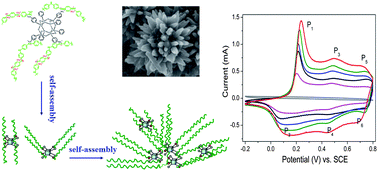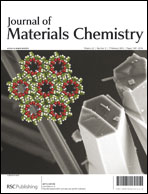In this work, polyhedral oligosilsesquioxane (POSS) was functionalized by direct sulfonation, and the porous and ordered hierarchical nanostructure of polyaniline/sulfonated polyhedral oligosilsesquioxane (PANI/SOPS) was subsequently fabricated by in situ polymerization. The morphologies of the PANI/SOPS nanocomposites can be controlled by adjusting the concentration of SOPS. The measurement of X-ray diffraction pattern and ultraviolet-visible spectra demonstrates the molecular level dispersion of SPOS in the PANI matrix. Synergetic interaction between PANI and SOPS significantly improves the porosity and the stability of the electrode, yielding excellent electrochemical properties. Compared to pure PANI, the PANI/SOPS electrode exhibits a higher specific capacitance of 1810 F g−1, faster oxidation/reduction at high current changes and better cyclic stability, which is attributed to the nano-architecture of the electrode materials and the support of the SOPS nanoparticles. This result suggests that the construction of the porous and ordered hierarchical nanostructure is a novel and effective way for improving the electrochemical properties of conducting polymers.

You have access to this article
 Please wait while we load your content...
Something went wrong. Try again?
Please wait while we load your content...
Something went wrong. Try again?


 Please wait while we load your content...
Please wait while we load your content...